Clumber Park, the Dukeries.
Above: 18th century engraving of Clumber Park.
Archaeological digs c.1960 found evidence that Clumber was once the site of a Bronze Age settlement. In Saxon times there would come to be two manors at Clumber, after which, as with similar properties across the country, the land was given over to a supporter of William the Conqueror. In this case Roger de Builli (Busli) who also gained Worksop. But to understand how Clumber became a ducal seat one first has to look to nearby Haughton.
Haughton was given over to Roger Pictavenis after the Conquest. Centuries and several family lines later it was sold by John Babington to Sir William Holles, Lord Mayor of London, in 1537. During the English Civil War the Holles families alternated between both Parliamentary and Royalist causes in order to keep possession of their estates. In 1663 Gilbert Holles of Haughton and his wife Grace Pierrepont of Thoresby, gave birth to John. John married Margaret Cavendish, heir of Henry 2nd Duke of Newcastle upon Tyne, seated at Welbeck. John then paid Henry’s debts, gaining in return the title 1st Duke of Newcastle upon Tyne (2nd creation). Choosing to live at Welbeck, Haughton Hall was left empty and eventually demolished. In 1711 John Holles died in a hunting accident and his estates were passed to his nephew Thomas Pelham-Holles with the title 1st Duke of Newcastle upon Tyne being created for a 3rd time. As the title could only be passed father to son, the title Duke of Newcastle under Lyme was created to overcome this legality, making further creations unnecessary. So when Thomas died without a son, his Dukedom became extinct and the title Duke of Newcastle under Lyne went to his nephew Henry Fiennes Pelham-Clinton, 2nd Duke of Newcastle under Lyne. It was this Duke who built Clumber House in 1770, making it his family seat. Designed by Stephen Wright it replaced the previous manor.
The Duke subsequently landscaped the surrounding park. The 4th Duke would be responsible for the construction of a one third scale frigate to sail on the lake, as well as planting the locally famous Lime Tree Avenue in 1838, still frequented today as a favoured public picnic spot. But he also spent much of his wealth recklessly. As reported on THIS POST he purchased Worksop Manor from the Duke of Norfolk, whose Catholic faith he didn’t approve of, only to demolish it soon afterwards.
In March 1879, shortly after the 6th Duke’s death, much of the original Clumber House (THIS LINK) was destroyed by fire. It was rebuilt by the 7th Duke of Newcastle and designed by Charles Barry. The Duke also commissioned George Frederick Bodley to design The Chapel of St Mary in 1886, replacing a former less satisfactory chapel dedicated to St Paul. A second fire in 1912, plus the financial effects of World War 1 and the subsequent Great Depression, resulted in Clumber House being abandoned and subsequently demolished in 1938. Happily, the superb chapel remains.
In 1941 secret trials of a trench digging tank called Nellie were carried out under the inspection of Winston Churchill, but the blitzkrieg rendered it obsolete before it was used.
Clumber Park is now the property of the National Trust.
You can read more about the first Thoresby Hall, the Dukeries, on THIS LINK, and more about Bess of Hardwick's role in the formation of the Dukeries on THIS LINK. You can read more about Worksop, the Dukeries, on THIS LINK and Welbeck, the Dukeries, on THIS LINK.
Labels: Clumber Park, Dukeries, Greyhound Lodge


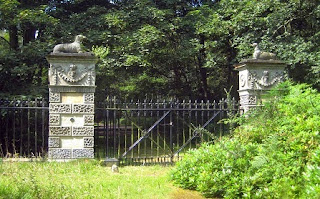





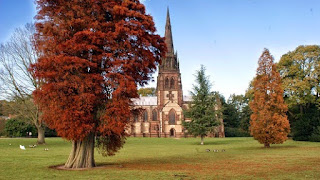
 Thoresby Hall Hotel, Sherwood Forest and Clumber Park are recommended attractions for a day trip or short vacation. The
Dukeries area is of keen historic interest. NOTE: Apart from public domain postcards and brochures ALL photographs herein are copyright Ian Gordon Craig, exclusive permission granted to Thoresby Estate for their use elsewhere.
Thoresby Hall Hotel, Sherwood Forest and Clumber Park are recommended attractions for a day trip or short vacation. The
Dukeries area is of keen historic interest. NOTE: Apart from public domain postcards and brochures ALL photographs herein are copyright Ian Gordon Craig, exclusive permission granted to Thoresby Estate for their use elsewhere.
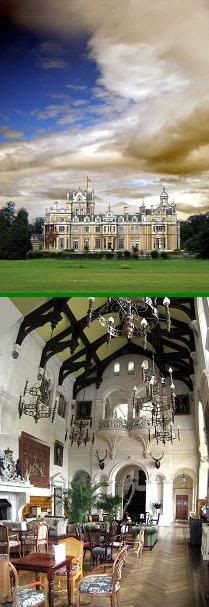 Thoresby Hall as photographed Summer 2009, now a successful Warners Hotel.
Thoresby Hall as photographed Summer 2009, now a successful Warners Hotel.
 Robert Pierrepont (1584 - 1643), 1st Earl of Kingston upon Hull, bought Thoresby for his second son William.
Robert Pierrepont (1584 - 1643), 1st Earl of Kingston upon Hull, bought Thoresby for his second son William.
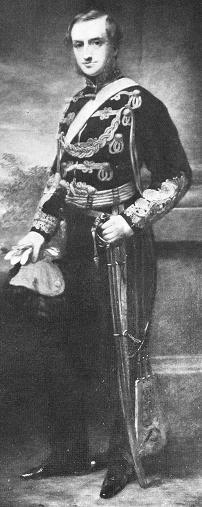 Sydney William Herbert Pierrepont (1825 - 1900), 3rd Earl Manvers, built the present Thoresby Hall, St John's Church,
Perlethorpe School, and generally shaped Thoresby Estate as it looks today.
Sydney William Herbert Pierrepont (1825 - 1900), 3rd Earl Manvers, built the present Thoresby Hall, St John's Church,
Perlethorpe School, and generally shaped Thoresby Estate as it looks today.
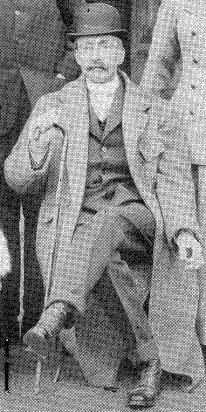 The 4th Earl Manvers (Died 1926).
The 4th Earl Manvers (Died 1926).
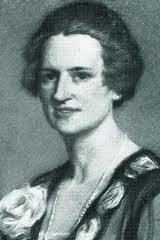 Countess Manvers (d.1984). Examples of her paintings are always on show at Thoresby Gallery.
Countess Manvers (d.1984). Examples of her paintings are always on show at Thoresby Gallery.
 ABOVE: The statue of Robin Hood in the courtyard at Thoresby Hall, by Tussaud - Birt, is showing its age, but remains one of
my favourites. The Art Gallery, crafts shops, and restaurant within that courtyard are recommended.
ABOVE: The statue of Robin Hood in the courtyard at Thoresby Hall, by Tussaud - Birt, is showing its age, but remains one of
my favourites. The Art Gallery, crafts shops, and restaurant within that courtyard are recommended.

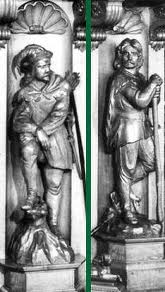
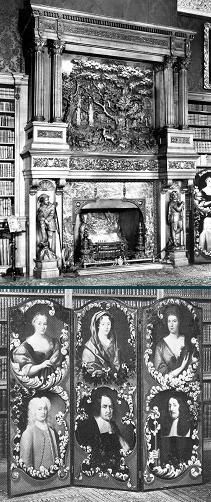 Carved oak fireplace in the Thoresby Hall library with its depiction of the Major Oak (Robin Hood's Tree), and the screen
featuring the Cromwell family. Oliver Cromwell is known to have stayed in Thoresby Hall before the English Civil War.
Carved oak fireplace in the Thoresby Hall library with its depiction of the Major Oak (Robin Hood's Tree), and the screen
featuring the Cromwell family. Oliver Cromwell is known to have stayed in Thoresby Hall before the English Civil War.
 The Green Bridge sited near the edge of the cricket pavilion in front of Thoresby Hall across which the Duke's carriage would take him to Perlethorpe Village.
The Green Bridge sited near the edge of the cricket pavilion in front of Thoresby Hall across which the Duke's carriage would take him to Perlethorpe Village.
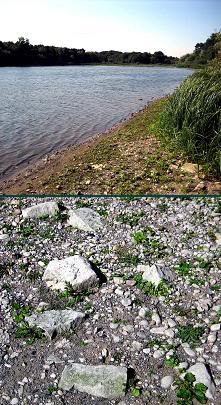 The view along Thoresby Lake towards Budby. Are these bricks at the water's edge remnants from the original Thoresby
Hall?
The view along Thoresby Lake towards Budby. Are these bricks at the water's edge remnants from the original Thoresby
Hall?
 The River Meden winds its way from 7 Ton Bridge near Thoresby Hall towards Perlethorpe Village.
The River Meden winds its way from 7 Ton Bridge near Thoresby Hall towards Perlethorpe Village.
 Budby Castle, once known as William Castle, and the River Meden winding towards Thoresby Lake under the remains of
Pierrepont Bridge, once described as classical and elegant.
Budby Castle, once known as William Castle, and the River Meden winding towards Thoresby Lake under the remains of
Pierrepont Bridge, once described as classical and elegant.
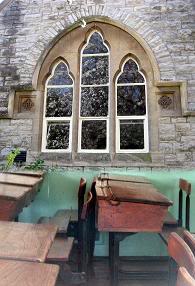
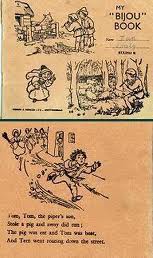 Children's exercise book from the school, 1958.
Children's exercise book from the school, 1958.
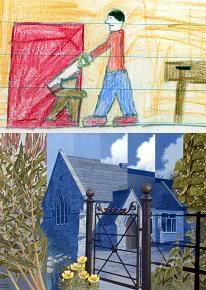
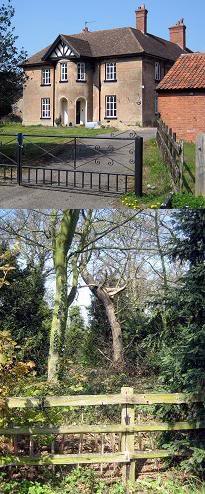



 Perlethorpe Church graveyard, where the original chapel once stood. The covered gate was a later addition in memorium to
the men of Budby and Thoresby who fell in World War 1.
Perlethorpe Church graveyard, where the original chapel once stood. The covered gate was a later addition in memorium to
the men of Budby and Thoresby who fell in World War 1.
 Robin Hood's Tree, the Major Oak, was once under the care and supervision of Thoresby Estate. Responsibility for its
upkeep changed to Nottingham City Council c.1969. Here it is pictured in in Spring, Autumn, and Winter.
Robin Hood's Tree, the Major Oak, was once under the care and supervision of Thoresby Estate. Responsibility for its
upkeep changed to Nottingham City Council c.1969. Here it is pictured in in Spring, Autumn, and Winter.

3 Comments:
The Dukeries, Clumber Park.
Sherwood Forest, the Dukeries, Thoresby park, history.
Pierrepont, Manvers, Dukeries, Thoresby Hall, Thoresby Hotel, Thoresby Park, Perlethorpe, Perlethorpe Village, Ollerton, Budby, Sherwood Forest.
Post a Comment
<< Home